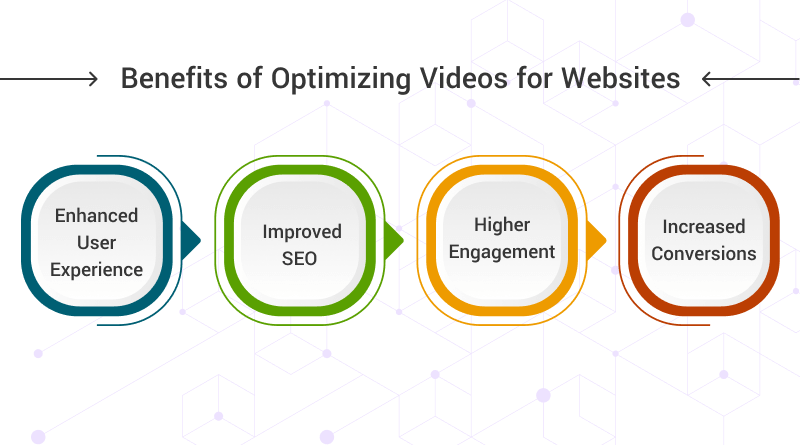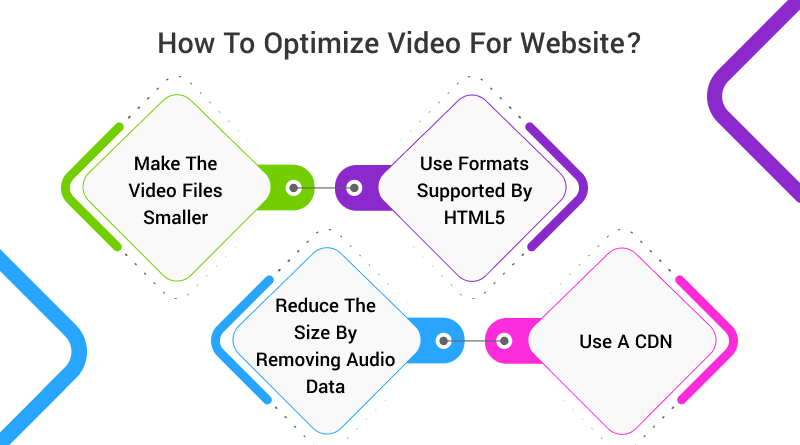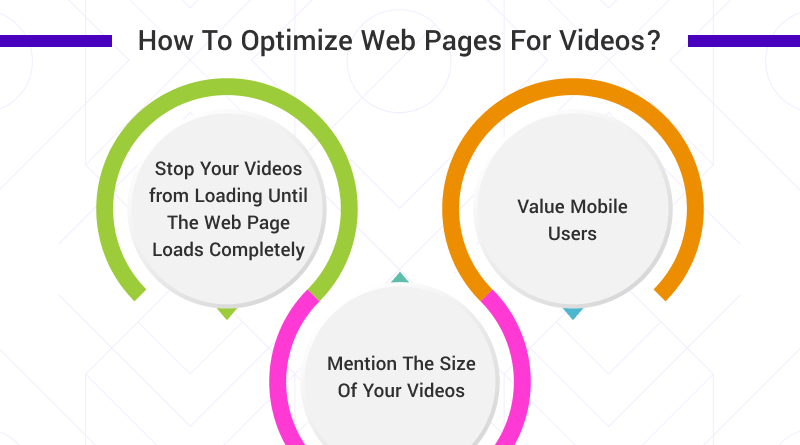According to the findings of recent surveys, adding videos to your landing page can increase conversions by almost 80%. Users tend to spend 88% more time on a website if it contains a video. This shows how important it is to include videos on your site. But as a beginner, did you know how to make videos load faster on websites? We are here to help!
However, what would happen if the video on your site doesn’t load quickly? The users will leave the site without checking what’s in store for them in the video; at least the numbers are suggesting so!
According to recent statistics, an average user doesn’t spend more than 15 seconds on a webpage.
This leaves us with the question – how to optimize video for website. Read through the section below to find out an answer and know the basics of adding videos to websites.
Benefits of Optimizing Videos for Websites
Optimizing videos for your website can bring a number of advantages, both for the viewers and for your business goals. Here are some of the key benefits:

1. Enhanced User Experience:
Optimized videos load faster, with smooth playback, and are easier for users to find through proper titling and tagging. This makes the experience of watching the video more enjoyable, and keeps visitors engaged with your website.
2. Improved SEO:
When you optimize your videos with relevant keywords in titles, descriptions, and tags, search engines are more likely to include them in search results. This increases the visibility of your website and the video itself, potentially driving more traffic.
3. Higher Engagement:
Optimized videos tend to be more engaging because people are more likely to watch them all the way through if they load quickly and provide value. This can lead to more shares, likes, and comments, further expanding the reach of your video.
4. Increased Conversions:
Well-crafted videos can be a powerful tool to convert viewers into customers. By using video to showcase products, explain services, or provide tutorials, you can effectively communicate your message and persuade visitors to take action.
Stats: The inclusion of more and more video content has made the average size of web pages more than 3 MB. Even a few years back, that number used to be around 1 MB. The average size of web videos has also increased from 204KB to more than 700KB. All these changes together have made video optimization mandatory for websites.
What Are the Best Video Formats For Websites?
When adding videos to your website, you should aim at using formats that will allow you to pack quality videos into small files. Two formats that meet this requirement are WebM and MP4. These are the most frequently used formats on top video streaming platforms. While WebM is currently supported just by Firefox and Chrome, MP4 videos work perfectly on all browsers.
How To Optimize The Video Loading Speed On Websites?
Video optimization done for ensuring high loading speed of videos on websites will require you to accomplish two tasks.
- Optimization of video files for ensuring that it has little or no effect on the loading speed of a web page
- Optimization of the web page for embedding and displaying video content immaculately
Read on to know how you can complete the two-step procedure…
How To Optimize Video For Website?
Below, we have mentioned the steps about how to optimize video for website.

1. Make The Video Files Smaller:
Media files that are smaller in size tend to load faster. You can reduce the size of your video files using data compression tools. Look for tools that can do the job without damaging the image quality of the videos. If you choose the wrong tool, you might be left with something similar to animated GIFs. Such videos will do more harm to your site than good.
2. Use Formats Supported By HTML5:
HTML5 allows developers to come up with video content without plugins. So, if your video format is not supported by HTML, use a video converter, and convert your existing video files into an HTML5 format. Examples of popular HTML5 formats include WebM and MP4.
3. Reduce The Size By Removing Audio Data:
This trick will work for you only if it’s a muted video. As having audio data is insignificant for muted videos, you can get rid of them and reduce the video’s size. When dealing with videos made by you, you can eliminate its audio data when exporting the files. On other occasions, you can do the job using a regular video editing tool.
4. Use A CDN:
CDN or content delivery network is a system constituted of multiple servers. These servers store cached copies of our website’s static content. Other than ensuring supreme redundancy, the CDNs enable prompt content delivery. They make this possible by sourcing content from the nearest servers.
This working procedure of CDNs is essential for managing large files like videos more efficiently. With a CDN in action, your users will not have to wait for several minutes for the videos to buffer and download.
How To Optimize Web Pages For Videos?
You must know tips and tricks to optimize portals before you know how to make video load faster on website.

1. Stop Your Videos from Loading Until The Web Page Loads Completely:
Web pages with videos start playing the videos right away when a visitor arrives at the page and they tend to load slowly at times. This reduces the video loading speed even further.
So, if you want the videos to load quickly, defer them from loading until the web pages they are on load completely. This will make the user experience much smoother.
2. Mention The Size Of Your Videos:
In your CSS or HTML, you should always specify the height and width of your videos. This will allow the browsers to assign suitable bandwidth without doing any extra effort.
3. Value Mobile Users:
The number of people visiting different websites from their smartphones and tablets is increasing with every passing day. So, if you haven’t optimized your website for mobiles you are on the wrong side of the trend.
Make sure the website is responsive. This means your site will be adaptable to all display resolutions and screen sizes. Additionally, the site must also be capable of detecting the orientation on the device for properly displaying the video.
Designing web pages that will look good on every screen size is not easy. One way of beating this problem is by building separate versions of your site for computers/laptops and mobile devices. However, that will leave you with additional maintenance duties.
One easy way of avoiding all such hassles is by preventing videos from getting downloaded on smaller screens. You can use CSS codes for adding this feature to your website.
Video Optimization For Achieving Higher Rank On Search Engines
You can always embed videos hosted on top streaming platforms on your website. However, if you aim to achieve a higher rank on Google’s result pages, you should consider hosting videos on your own domain.
Uploading a video on a streaming platform along with your website’s link will not give you the benefit you are looking for. Google will give preference to the streaming platform and not to your website.
Self-hosting your videos will offer you significant flexibility when deciding on the look and feel of your video content. Additionally, you will be able to offer add-free content to your visitors. The absence of distractions will automatically increase your chances of getting more visitors on your site.
However, for self-hosting your videos seamlessly you must host your website on a dedicated server. Shared hosting offers restricted bandwidth, which can create issues if a self-hosted video goes viral.
The discussion above must have helped you to understand the importance of optimizing the video loading speed on your website. It also explains the easiest ways of carrying out the optimization.
For instance, for optimizing the video loading speed, you will have to optimize the video files and then optimize your web pages for those videos. You should be able to complete both these steps using a few simple tools.
Other than increasing the loading speed of your videos, you should make sure that the videos are helping in increasing your site’s visibility.
Hosting the videos on a third-party streaming platform might not be the best way of increasing the visibility of your site. You should look to self-host the videos and for that, you will have to put the site on a dedicated server.
Self-hosting will force Google to give preference to your site, which will automatically increase your site’s rank on search engine result pages.
FAQs-How To Optimize The Video Loading Speed On Your Website?
Why is video loading speed important for a website?
Fast loading videos are essential for a positive user experience. Attention spans are shrinking, and users expect webpages to load in under 3 seconds. If a video takes too long to load, many visitors will simply abandon the site. It offers different benefits like higher engagement, enhanced conversions, better search engine optimization.
What are some common factors that affect video loading speed on a website?
Larger video files naturally take longer to load. High-resolution videos create larger files compared to lower resolutions. Choosing the right resolution for your needs is crucial. Certain formats, like high-definition (HD) videos, have a bigger file size compared to others. Selecting the appropriate format that balances quality and file size is important.
How can I reduce the file size of videos to improve loading speed?
For most web videos, using a lower resolution (like 720p) instead of HD (1080p) is sufficient. The slight decrease in quality is often undetectable for viewers but significantly reduces file size. Compression reduces file size while maintaining acceptable video quality. Different compression techniques offer varying levels of quality and file size reduction. Experiment to find the right balance for your videos.
What video formats are best for fast loading speeds?
MP4 is the widely compatible format offers good compression for web use, making it a popular choice for online videos. WebM is also a good option with excellent compression capabilities. However, not all browsers support WebM, so consider your target audience before using this format.















